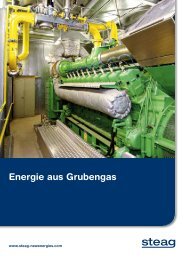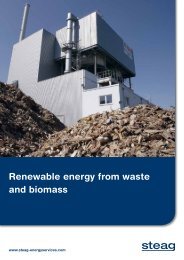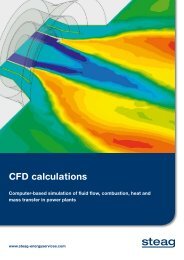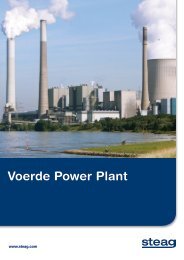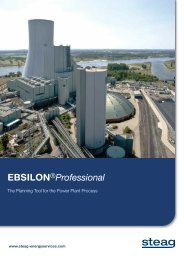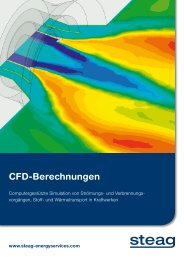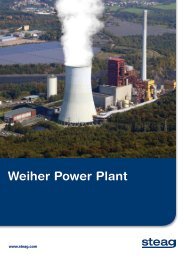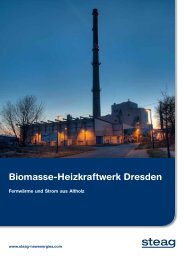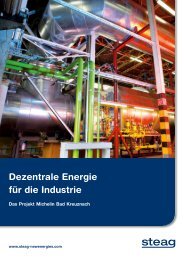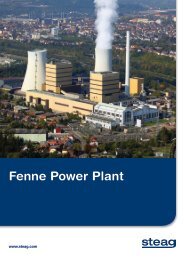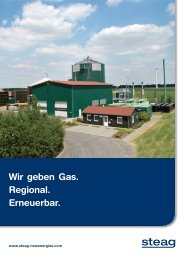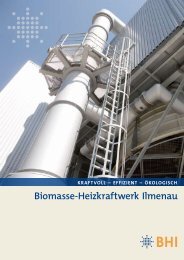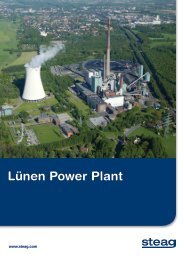english - STEAG
english - STEAG
english - STEAG
You also want an ePaper? Increase the reach of your titles
YUMPU automatically turns print PDFs into web optimized ePapers that Google loves.
Leuna<br />
Refinery Power Plant<br />
www.steag.com
Power and heat for the future<br />
Efficient energy supply for the<br />
Leuna refinery complex<br />
As fifth biggest electricity producer in Germany, with ultramodern<br />
power plants in and outside Germany and a variety of<br />
services, <strong>STEAG</strong> GmbH safeguards the energy supply of the<br />
future – reliably, efficiently, and with low environmental impact.<br />
<strong>STEAG</strong> blazes the trail for the energy sources biomass,<br />
biogas, mine gas, geothermics, wind and solar thermics. The<br />
engineers of <strong>STEAG</strong> Energy Services GmbH develop, build<br />
and operate power plants all over the world and are experts<br />
for the modernization of existing plants and for made-tomeasure<br />
energy supply which goes easy on the climate and<br />
at the same time is economical.<br />
Power plants at home and abroad<br />
<strong>STEAG</strong> operates eleven power plants at ten locations in<br />
Germany with an installed capacity of about 7,500 MW; nine<br />
of these plants use hard coal as primary energy source. At<br />
two sites, each of which integrates an industrial power plant,<br />
refinery by-products also are used to produce steam, compressed<br />
air and electricity. Most of the electricity from hard<br />
coal is supplied to industrial and public utilities. The customers<br />
include RWE, EnBW and Deutsche Bahn, the German<br />
Railways. Where there is a demand for it, cogeneration –<br />
the simultaneous production of power and useful heat – is<br />
practiced. This heat either is used for heating purposes or<br />
is purchased by industrial enterprises in the form of process<br />
heat for their production processes. Outside Germany, too,<br />
the company contributes to public power supply with three<br />
hard-coal-fired power plants, capacity about 1,700 MW, in<br />
Turkey, Colombia and the Philippines. The efficient power<br />
plants of <strong>STEAG</strong> make an active contribution to a secure and<br />
sustainable supply of energy.<br />
The Leuna refinery power plant is located on the grounds of<br />
the Leuna chemical park, one of the biggest industrial chemicals<br />
sites in Germany. The power plant supplies the refinery<br />
at the site with electricity, process steam, compressed air,<br />
process water, feedwater and cooling water. The supply of<br />
energy to the refinery in Leuna was the first project of its kind<br />
worldwide. Up until then, the oil companies had financed,<br />
built and operated their power plants themselves. In Leuna,<br />
for the first time an external partner, <strong>STEAG</strong>, was given a<br />
chance. Thanks to <strong>STEAG</strong>’s longstanding know-how, it was<br />
and is possible to use refinery residues as fuel despite stiffer<br />
environmental protection regulations.<br />
Symbiosis of power plant and refinery<br />
The smooth cooperation between power plant and refinery is<br />
important for supplying the site. This symbiosis has functioned<br />
almost without a hitch since 1996. One chief reason<br />
for this is the close coordination between power plant and<br />
refinery concerning current energy consumption and operative<br />
measures.<br />
Via online links each party is well informed about the current<br />
operating data of the other party. This coordination is backed<br />
up by long-term and medium-term planning. Power plant<br />
and refinery begin at midyear to draw up the schedule for the<br />
coming year.<br />
<strong>STEAG</strong> also continually invests in the power plant site in order<br />
to meet the changing needs of the refinery. For example,<br />
paralleling the expansion of the refinery processing capacity<br />
from just under 10 million tons of crude to 12 million tons<br />
annually, investments were made in 30 projects at the power<br />
plant to increase its reliability and energy efficiency. In refinery<br />
power plants, capacity is not as important as availability, because<br />
the refinery is dependent on an uninterrupted supply<br />
of energy.
The power plant<br />
Site plan<br />
Characteristic of the Leuna refinery power plant is that it<br />
self-sufficiently supplies the refinery and installations belonging<br />
to the complex with electricity, process steam at<br />
various pressure levels, compressed air and various process<br />
waters, feedwaters and cooling water. The fuels used are<br />
very viscous distillation and conversion residues from the<br />
refinery process. Owing to the sophisticated environmental<br />
technology of <strong>STEAG</strong>, especially the highly efficient flue gas<br />
desulfurizing (FGD) system, these residues are turned into<br />
raw materials again.<br />
The residues are delivered via pipework at a temperature of<br />
about 150 °C. The fuels are stored for the interim in tanks<br />
in the power plant and then preheated to around 230 °C. In<br />
addition, excess fuel gas from the refinery and synthesis gas<br />
from a methanol plant find use.<br />
The fuel is injected into the boiler at a temperature of 230 °C.<br />
There it burns and heats the water in the boiler tubes to<br />
make steam. The steam drives the turbines and is transformed<br />
into electricity in the generators or supplied directly to<br />
the refinery as process steam.<br />
Annually, 250,000 tons of these high-viscosity oils, as the<br />
black mass is termed, are processed in this way in the Leuna<br />
refinery power plant. For one thing, this saves disposal costs<br />
and, for another, it reduces the use of fossil energy sources.<br />
The refinery needs large quantities of steam at differing pressure<br />
levels to drive pumps and turbine-driven units as well as<br />
for mass transfer. Process water and boiler feedwater for the<br />
refinery come from the water treatment plant. The required<br />
cooling water is made available from a closed recooling water<br />
circuit constructed specifically for the refinery.<br />
The power plant also operates a water demineralizing plant.<br />
It works on the reverse osmosis principle and, with its capacity<br />
of 510 m 3 / h, is one of the biggest in Europe.<br />
In addition, the condensates returning from the refinery<br />
(410 m 3 / h) are treated in a dedicated condensate polishing<br />
plant and returned to the process water and feedwater.<br />
1<br />
2<br />
2<br />
4<br />
5<br />
18 18<br />
3 3<br />
3 3<br />
6<br />
18 19<br />
17<br />
7<br />
12<br />
11 11 11<br />
10 10 10<br />
8 8 8 9<br />
18<br />
7<br />
7<br />
16<br />
17 17<br />
13<br />
14<br />
20<br />
15 15 15<br />
22 21<br />
23 24 24<br />
25 27 26<br />
1 Gatehouse<br />
2 Fuel tank<br />
3 Fuel tank<br />
4 Fuel supply / preheating<br />
5 Fuel supply / preheating<br />
6 Fuel supply / preheating<br />
7 Boilerhouse with DeNo x<br />
8 Wet electrostatic precipitator<br />
9 FGD wastewater treatment plant<br />
10 Scrubber<br />
11 Quench cooler / stack<br />
12 Quench cooler / stack<br />
13 FGD wastewater treatment plant<br />
14 Gypsum silo<br />
15 NH 3<br />
supply system<br />
16 Turbine house<br />
17 Transformer<br />
18 Transformer<br />
19 Switchgear building and control room<br />
20 Switchgear building<br />
21 Demin water plant<br />
22 Demin water plant<br />
23 Demin water plant<br />
24 Demin water plant<br />
25 Cooling towers<br />
26 Cooling towers<br />
27 Cooling towers
Data and facts *<br />
Installed capacity 162 MW (of which 56 MWel equivalent = 204 MW th<br />
)<br />
Useful electricity output<br />
Steam and compressed air output<br />
Fuel input<br />
about 558 GWh / a<br />
about 282 GWh / a<br />
about 330,000 tce<br />
Components 1 demineralization plant (510 t / h)<br />
1 HP steam turbine (33.6 MWel)<br />
1 IP steam turbine (38.3 MWel)<br />
1 LP steam turbine (34.2 MWel)<br />
3 oil-fired boilers (178 t / h each)<br />
1 gas-fired boiler (156.6 t / h)<br />
Initial start-up 1996<br />
Operator<br />
Owner<br />
RKB Raffinerie-Kraftwerks-Betriebs GmbH<br />
<strong>STEAG</strong>-Raffinerie-Kraftwerk-Sachsen-Anhalt GmbH<br />
<strong>STEAG</strong> refers to the gross maximum capacity under nominal<br />
conditions as installed capacity. This is the continuous<br />
output that can be attained under normal conditions. It is<br />
limited by the weakest part of the plant (bottleneck), is determined<br />
by measurement and converted to normal conditions;<br />
stated in MW, calculated as MW electric and equivalent<br />
(thermal output).<br />
The standard coal equivalent or ton of coal equivalent<br />
(tce) is a commonly used unit of measure in Central Europe,<br />
though not a statutory unit of measure, to compare the energy<br />
content of primary energy sources. 1 ton coal equivalent =<br />
29.3076 gigajoules (GJ) = 8.141 thermal megawatt-hours<br />
(MWh th<br />
).<br />
A site with a tradition<br />
The Leuna refinery power plant is located on the grounds<br />
of the Leuna chemical complex, which is very well known<br />
for its past history and outstanding developments. Leuna<br />
gained an international reputation through its coal hydrogenation<br />
processes. Nobel Prizes for scientists at the site in the<br />
1920s and 1930s attest to this. The changeover to the raw<br />
material petroleum took place in several stages in the early<br />
1950s. After the turnabout in East Germany in 1989, the Elf<br />
Group (today TOTAL) won a contract to build a completely<br />
new refinery in Leuna. This was the birth of TOTAL-Raffinerie<br />
Mitteldeutschland (TRM), the most up-to-date, most efficient<br />
refinery in Europe.<br />
<strong>STEAG</strong>, which already had built a combined-cycle power<br />
plant and a demineralizing plant in Leuna, was commissioned<br />
by Elf to build the refinery power plant. All in all this<br />
was a project of superlatives, for it was the biggest German-<br />
French economic investment of the postwar period. After just<br />
about two years of construction, the industrial power plant<br />
took up commercial operation in December 1996.<br />
* as at December 31, 2011
<strong>STEAG</strong> GmbH<br />
Rüttenscheider Strasse 1–3<br />
45128 Essen<br />
Germany<br />
Phone +49 201 801-00<br />
Fax +49 201 801-6388<br />
Email info@steag.com<br />
www.steag.com<br />
RKB Raffinerie-Kraftwerks-Betriebs GmbH<br />
Werkteil II Bau 3691<br />
06237 Leuna<br />
Germany<br />
Phone +49 3461 548-2222<br />
Fax +49 3461 548-2209<br />
Email info-rkb@steag.com<br />
V-UK, as at June 2012



